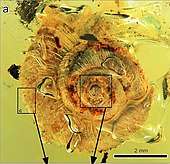Cyclophoridae
Cyclophoridae is a taxonomic family of small to large tropical land snails with an operculum, terrestrial gastropod mollusks in the informal group Architaenioglossa belonging to the clade Caenogastropoda (according to the taxonomy of the Gastropoda by Bouchet & Rocroi, 2005).
| Cyclophoridae | |
|---|---|
| A live but withdrawn individual of Leptopoma nitidum | |
| Scientific classification | |
| Kingdom: | Animalia |
| Phylum: | Mollusca |
| Class: | Gastropoda |
| Clade: | Caenogastropoda |
| Informal group: | Architaenioglossa |
| Superfamily: | Cyclophoroidea |
| Family: | Cyclophoridae Gray, 1847 |
| Subfamilies | |
|
Alycaeinae | |
| Synonyms | |
|
Alycaeidae Blanford, 1864 | |
This diverse family with many species is now limited to the representatives in the tropics and subtropics of the Old and New World.
Their fossil history dates back through the Early Tertiary[1] to the Cenomanian age of the Cretaceous.[2]
Description
The dextral shells are mostly of small and rarely medium size. The form of the shell varies from discoidal to turbinate. The round aperture is often modified, sometimes with an incision or a constriction. The last whorl can sometimes be disconnected and then extends strongly from the winding plane. The operculum is generally circular, which can be retracted deeply into the shell. Its form is multispiral and can be calcified or lacking calcareous overlay. The outer layer of the operculum can contain accessory deposits.
The head of the soft body ends in a short proboscis. The tentacles are round in cross-section, relatively long and taper to the end. The eyes are located at the base of the antenna on flat papillae. The longitudinal muscular foot is not divided. The mantle cavity acts as a lung cavity. The taenioglossan radula has seven elements per transverse row. The central row of the radula contains usually five, rarely three or seven teeth. The animals are dioecious.
Taxonomy and systematics

This family consists of the following subfamilies according to the taxonomy of the Gastropoda by Bouchet & Rocroi, 2005, which adapted the tribes of Cyclophorinae from the system used by Wenz (1938).[3] Thirty five genera containing approximately 810 species have been recognized.[4]
Some notable genera are also listed here:
- Subfamily Alycaeinae Blanford, 1864
- Incertae sedis
- Alycaeus Gray, 1850
- Anosycolus Fischer-Piette, C.P. Blanc, F. Blanc & Salvat, 1993
- Awalycaeus Kuroda, 1951
- Chamalycaeus Kobelt & Möllendorff, 1897
- Dicharax Kobelt & Möllendorff, 1900
- Dioryx Benson, 1859
- Metalycaeus Pilsbry, 1900
- Pincerna Preston, 1907
- Incertae sedis
- Subfamily Cyclophorinae Gray, 1847
- Tribe Caspicyclotini Wenz, 1938
- Caspicyclotus Forcart, 1935
- Tribe Cyathopomatini Kobelt & Möllendorff, 1897
- Cyathopoma Blanford & Blanford, 1861
- Jerdonia Blanford & Blanford, 1861
- Mychopoma Blanford, 1869
- Pseudojerdonia Kobelt, 1902
- Tribe Cyclophorini Gray, 1847
- Afroditropis Bequaert & Clench, 1936
- Craspedotropis Blanford, 1864
- Crossopoma von Martens, 1891
- Cyclophorus Montfort, 1810
- Cyclosurus Morelet, 1881
- Ditropopsis Smith, 1897
- Elgonocyclus Verdcourt, 1982
- Japonia Gould, 1859
- Lagocheilus Blanford, 1864
- Leptopoma Pfeiffer, 1847
- Leptopomoides Nevill, 1878
- Micraulax Theobald, 1876
- Montanopoma Stanisic, 2010
- Myxostoma Troschel, 1847
- Otopoma Gray, 1850
- Owengriffithsius Emberton, 2002
- Papuocyclus Ancey, 1895
- Pilosphaera Lee, Lue & Wu, 2008
- Ptychopoma Möllendorff, 1885
- Scabrina Blanford, 1863
- Theobaldius Nevill, 1878
- Tribe Cyclotini Pfeiffer, 1853
- Cyclotus Swainson, 1840
- Opisthoporus Benson, 1851
- Platyrhaphe Möllendorff, 1890
- Tribe Pterocyclini Kobelt & Möllendorff, 1897
- Millotorbis Fischer-Piette & Bedoucha, 1965
- Pterocyclos Benson, 1832
- Rhiostoma Benson, 1860
- Spiraculum Pearson, 1833
- Incertae sedis
- Pholeoteras Sturany, 1904
- Tribe Caspicyclotini Wenz, 1938
- Incertae sedis
- Incertae sedis
- †Archaeocyclotus Asato & Hirano, 2019
- †Pseudarinia Yen, 1952
- Ventriculus Wenz in Fischer & Wenz, 1914
- Incertae sedis
- Subfamily Spirostomatinae Tielecke, 1940
- Incertae sedis
- Spirostoma Heude, 1885
- Incertae sedis
References
- Gordon MS, Olson EC (1995) Invasions of the Land: The Transitions of Organisms from Aquatic to Terrestrial Life. Columbia University Press, New York, 312 pp
- Hirano, T.; Asato, K.; Yamamoto, S.; Takahashi, Y.; Chiba, S. (2019). "Cretaceous amber fossils highlight the evolutionary history and morphological conservatism of land snails". Scientific Reports. 9 (1): Article number 15886. Bibcode:2019NatSR...915886H. doi:10.1038/s41598-019-51840-3. PMC 6828811. PMID 31685840.
- (in German) Wenz W. (1938-1944) Teil 1: Allgemeiner Teil und Prosobranchia. In: Schindewolf O. H. (ed.) Handbuch der Paläozoologie, Band 6, Gastropoda, Verlag Gebrüder Bornträger, Berlin, xii + 1639 pp.
- Lee YC, Lue KY, Wu WL (2008) Molecular evidence for a polyphyletic genus Japonia (Architaenioglossa: Cyclophoridae) and with the description of a new genus and two new species. Zootaxa 1792: 22-38.
Sources
| Wikimedia Commons has media related to Cyclophoridae. |
- Kobelt, W. (1909). Cyclophoridae. Berlin: Verlag von R. Friedländer und Sohn. The standard reference based on shell morphology.
- Nantarat, N., Sutcharit, C., Tongkerd, P., Ablett, J., Naggs, F. & Panha, S. (2014). An annotated catalogue of type specimes of the land snail genus Cyclophorus Monfort, 1810 (Caenogastropoda, Cyclophoridae) in the Natural History Museum, London. ZooKeys, 411, 1–56.